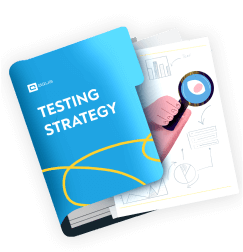QA testing ensures the outstanding quality of banking applications before releasing them to the customers. Testing ensures that the product is defect-free, enables seamless transactions, and delivers a great customer experience.
Hence, banking systems need to leverage QA testing to get high-quality and flawless banking applications. Banks have to comply with specific regulations, rules, and regulations. Eventually, all banking systems require QA testing to validate that they are not dropping on open banking API terms and conditions. This process is called software QA compliance in banking. Which, in simple terms, means that software is developed and tested according to the predefined standards.
What steps does a QA team take to succeed in the audit?
Advanced technologies such as AI, cloud services, machine learning, and blockchain are rising with more digitization in banking systems. However, customer experience (CX) and customer data security remain the primary focus for the financial sector. As a result, banking systems are looking to improve their applications, simplify customer journeys, and provide a seamless omnichannel experience. This goal involves a good QA process with expert QA professionals specialized in various testing types. QA team needs to execute all kinds of testing to pass the QA full-fledged verification successfully.
Some necessary testing’s which are mandatory for the QA team to test banking applications are described here:
✅ Banking applications typically have an N-tier architecture.
The most common 3-tier architecture has three layers, i.e., application, presentation, and data layers. Since the Application interface (API) layers contain the logic of an application so, it requires end-to-end QA testing. New business opportunities are offered at the core of banking services by using Open APIs. Therefore, the back-end and middleware systems should support open APIs to enable such services. This alliance involves complex integrations. Banking servers and applications should be tested and assured thoroughly to avoid server outages and ensure high-performing applications under all load conditions. Consequently, verifying all these underlying layers through API testing with an intense quality assurance process becomes mandatory.
✅ Banking systems need large-scale Integration with third-party apps such as eCommerce apps, apps, restaurants, etc.
Therefore, Integration and functional testing of banking systems are essential to ensure that these third-party services are appropriately integrated with Banking applications.
✅ Data security should be assured through security testing.
Therefore, it is vital to perform vulnerability testing of banking systems to check if there are any security loopholes present in the system that cyber attackers can exploit.
✅ If the cloud is part of a banking software application, then cloud app testing must be done to ensure the smooth functioning of cloud solutions.
This cloud testing process also ensures that data is transferred successfully without damage during data migration for the banking system.
✅ Customers access the banking applications on different mobile devices, operating systems, and browsers.
Accordingly, banking systems must ensure their banking apps are compatible with several devices, OS, etc. Compatibility testing must be performed across all possible platforms.
✅ Seamless application navigation requires usability testing.
Customers can access the app through the link on the mobile or web, so the respective application should be open. This behavior can be ensured through useability testing.
✅ Banking applications provide services to almost all populations, including older adults, young, educated, less educated, etc.
It becomes essential to design banking applications that follow all accessibility regulations and enable easy access to a differently-abled population to ensure inclusivity and fulfill societal responsibility. This behavior is verified through accessibility testing.
✅ The banking sector is continually endeavoring to utilize AI to enable high-level data analytics, decrease fraudulent activities and save high costs and time.
As a result, the business value of AI in global banking will be reached to $300 billion by 2030, as per the IHS Markit report from April 2019. Thus, AI testing of the banking system is necessary to help the banking sector verify effective AI implementation to ensure innovation and deliver exceptional customer experience.
If you’re intrigued by the strategic aspect of QA compliance, have a look at our testing strategy template. It covers both meeting regulatory requirements and steps to maximise your testing output.

Get a compliant & highly efficient testing strategy template
How to find your best ALM solution to get through QA compliance in banking successfully?
We’ve prepared for you an intuitive chart with the comparisons of the suitable QA ALM solutions to help you with compliance in banking.
| Features | aqua | Octane | Polarion | Codebeamer | Practitest | Tuleap | XRay | Testrail | QMeter | Zephyr | Qtest | Microfocus |
| Project management | + | + | + | + | + | + | + | + | + | + | + | + |
| Code versioning | + | + | + | + | – | + | + | – | – | + | + | + |
| Code Review | + | + | + | + | + | + | – | + | – | + | – | + |
| Continuous Integration | + | + | + | + | + | + | + | + | + | + | + | + |
| Test management | + | + | + | + | + | + | – | + | + | + | + | + |
| Documents and deliveries | + | + | – | + | – | + | – | – | – | – | – | – |
| Requirements baseline | + | + | + | + | + | + | – | + | + | + | – | + |
| Defect tracking | + | + | – | + | + | + | – | + | – | + | + | + |
| Test reporting | + | + | + | + | + | + | + | + | + | + | + | + |
| Test results | + | + | + | + | + | + | + | + | + | + | + | + |
| Test execution cycles | + | + | + | + | + | – | + | + | + | + | + | + |
| Test planning | + | + | – | + | + | + | + | + | + | + | – | – |
| Tools integration with Jira | + | + | + | + | + | + | + | + | + | + | + | + |
| Test automation support | + | + | + | – | + | + | + | + | – | – | + | – |
Wrapping up
To ensure a great quality of banking applications before releasing them to the market, QA teams have to perform financial application testing and get compliant with the requirements of ECB. There are tools to help with that, ALMs which can support the QA team throughout out all the process. It is crucial to pick the fit one, so use our table to do so!
aqua cloud brings more than compliance. It is an AI-powered test management system that allows you to quickly generate tests from requirements and complete test case drafts. aqua has a high-profile client portfolio with banking, insurance, and government agencies among the clients.
Get a compliant AI-powered test management system






